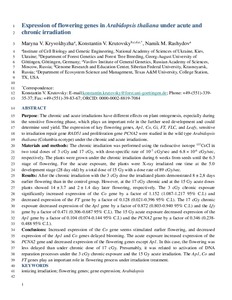Показать сокращенную информацию
Differential expression of flowering genes in Arabidopsis thaliana under chronic and acute ionizing radiation
| Автор | Maryna V. Kryvokhyzha | |
| Автор | Konstantin V. Krutovsky | |
| Автор | Namik M. Rashydov | |
| Дата внесения | 2020-01-20T08:01:50Z | |
| Дата, когда ресурс стал доступен | 2020-01-20T08:01:50Z | |
| Дата публикации | 2019-05 | |
| Библиографическое описание | Maryna V. Kryvokhyzha. Differential expression of flowering genes in Arabidopsis thaliana under chronic and acute ionizing radiation [Текст] / Maryna V. Kryvokhyzha, Konstantin V. Krutovsky, Namik M. Rashydov // International Journal of Radiation Biology. — 2019. — Т. 95 (№ 5). — С. 626-634 | |
| ISSN | 09553002 | |
| URI (для ссылок/цитирований) | https://www.tandfonline.com/doi/pdf/10.1080/09553002.2019.1562251 | |
| URI (для ссылок/цитирований) | https://elib.sfu-kras.ru/handle/2311/129603 | |
| Аннотация | Purpose: The chronic and acute irradiations have different effects on plant ontogenesis, especially during the sensitive flowering phase, which plays an important role in the further seed development and could determine seed yield. The expression of key flowering genes, Ap1, Co, Gi, FT, FLC, and Leafy, sensitive to irradiation repair gene RAD51 and proliferation gene PCNA2 were studied in the wild type Arabidopsis thaliana (Columbia ecotype) under the chronic and acute irradiations. Materials and methods: The chronic irradiation was performed using the radioactive isotope 137СsCl in two total doses of 3 cGy and 17 cGy, with dose-specific rate of 10-7 cGy/sec and 6.8 × 10-6 cGy/sec, respectively. The plants were grown under the chronic irradiation during 6 weeks from seeds until the 6.3 stage of flowering. For the acute exposure, the plants were X-ray irradiated one time at the 5.0 development stage (28 day old) by a total dose of 15 Gy with a dose rate of 89 cGy/sec. Results: After the chronic irradiation with the 3 cGy dose the irradiated plants demonstrated 8 ± 2,8 days earlier flowering than in the control group. However, at the 17 cGy chronic and at the 15 Gy acute doses plants showed 14 ± 3.7 and 2 ± 1.4 day later flowering, respectively. The 3 cGy chronic exposure significantly increased expression of the Co gene by a factor of 1.152 (1.087-1.217 95% C.I.) and decreased expression of the FT gene by a factor of 0.128 (0.021-0.396 95% C.I.). The 17 cGy chronic exposure decreased expression of the Ap1 gene by a factor of 0.872 (0.803-0.940 95% C.I.) and the Lfy gene by a factor of 0.471 (0.306-0.687 95% C.I.). The 15 Gy acute exposure decreased expression of the Ap1 gene by a factor of 0.104 (0.074-0.144 95% C.I.) and the PCNA2 gene by a factor of 0.346 (0.238-0.488 95% C.I.). Conclusions: Increased expression of the Co gene seems stimulated earlier flowering, and decreased expression of the Ap1 and Co genes delayed blooming. The acute exposure increased expression of the PCNA2 gene and decreased expression of the flowering genes except Ap1. In this case, the flowering was less delayed than under chronic dose of 17 cGy. Presumably, it was related to activation of DNA reparation processes under the 3 cGy chronic exposure and the 15 Gy acute irradiation. The Ap1, Co and FT genes play an important role in flowering process under irradiation treatment. | |
| Тема | ionizing irradiation | |
| Тема | flowering genes | |
| Тема | gene expression | |
| Тема | Arabidopsis | |
| Название | Differential expression of flowering genes in Arabidopsis thaliana under chronic and acute ionizing radiation | |
| Тип | Journal Article | |
| Тип | Journal Article Preprint | |
| Страницы | 626-634 | |
| ГРНТИ | 34.15.23 | |
| Дата обновления | 2020-01-20T08:01:50Z | |
| DOI | 10.1080/09553002.2019.1562251 | |
| Институт | Институт фундаментальной биологии и биотехнологии | |
| Подразделение | Базовая кафедра защиты и современных технологии мониторинга лесов | |
| Журнал | International Journal of Radiation Biology | |
| Квартиль журнала в Scopus | Q2 | |
| Квартиль журнала в Web of Science | Q1 |

